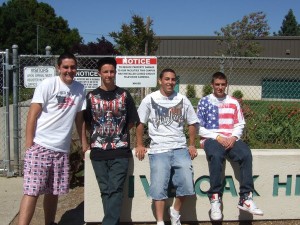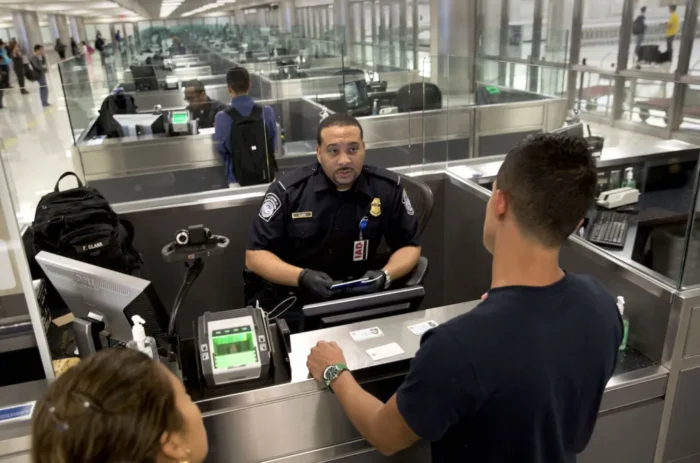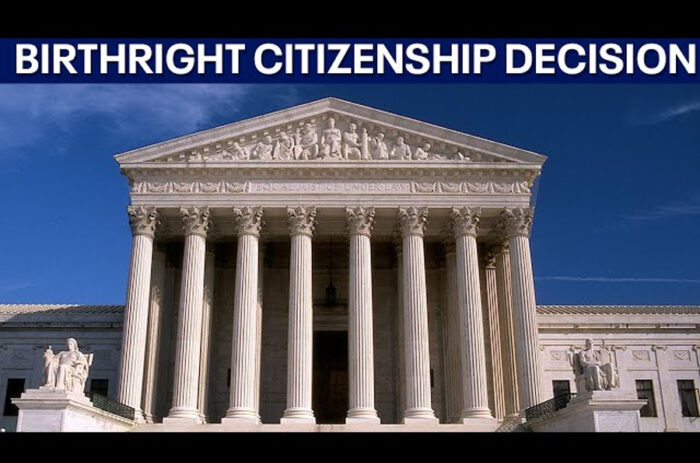redo Jump to...
print Print...

These students and another friend were told to turn their American flag t-shirts inside out or go home after wearing them to their California high school on Cinco de Mayo day.
(by Patrik Jonsson, The Christian Science Monitor) – The right of American students to wear to school patriotic clothing – or just an image of the US flag – is at the core of a constitutional case that went in front of the Ninth Circuit Court of Appeals in San Francisco on Thursday. [The court is expected to rule on the case in the next few months.]
On May 5, 2010, Live Oak High School officials in Morgan Hill, Calif., told three students to go home after they refused to turn their US flag-themed T-shirts inside out during Cinco de Mayo, the celebration of a Mexican battle victory over France. Administrators cited lingering racial tensions at the school between Hispanics and Anglos dating back to the previous year’s Cinco de Mayo celebration.
In their lawsuit, the students – listed as D.M., M.D., and D.G. – contend that there is no evidence that the T-shirts had sparked any disruptions and that “American schools cannot logically ban the American flag for any duration or reason.” …
The students lost the first round in November 2011 when a US district judge ruled that school officials were within their rights to send the students home. Judge James Ware cited concerns where the flag-wearing Anglo students could be in danger of attack from angry Hispanic students.
“Although no school official can predict with certainty which threats are empty and which will lead to true violence, the Court finds that these school officials were not unreasonable in forecasting that the Plaintiffs’ clothing exposed them to significant danger,” Judge Ware wrote.
 Public school officials have broad powers to establish dress codes, such as restricting certain colors in clothing or barring the wearing of sports jerseys, in areas where gangs are considered a problem. But the American flag case poses different questions about how far school officials can go in reacting to a potential problem by spontaneously barring what students wear, even if that includes a T-shirt bearing the American flag. According to Eugene Volokh, a University of California law professor and free speech expert, the American flag case will turn on whether the administrators overreacted in barring the American flag in the face of a perceived threat of violence.
Public school officials have broad powers to establish dress codes, such as restricting certain colors in clothing or barring the wearing of sports jerseys, in areas where gangs are considered a problem. But the American flag case poses different questions about how far school officials can go in reacting to a potential problem by spontaneously barring what students wear, even if that includes a T-shirt bearing the American flag. According to Eugene Volokh, a University of California law professor and free speech expert, the American flag case will turn on whether the administrators overreacted in barring the American flag in the face of a perceived threat of violence.
In their lawsuit, the students dismiss the idea that the T-shirts posed the threat of violence or disruption, largely because the students had been in school that day for more than three hours and there had been no reports of problems. They also dismissed attempts to draw parallels to the banning of Confederate flag symbols by some schools, saying the US flag is viewed far differently.
But even if the T-shirts had sparked a reaction, that shouldn’t automatically prompt an administration crackdown, other scholars suggest.
“The fact is, in political speech, you get hecklers because political speech riles people up, but that’s not the same as violence,” says Trevor Burrus, a research fellow at the Cato Institute’s Center for Constitutional Studies in Washington. “Schools should allow students to be riled up and have conversations about what’s around them. The other concern here is that the modern liberal school system is based more on the ‘no one should ever be offended’ doctrine rather than the ‘robust political speech’ doctrine.”
So the question before the court Thursday was whether public school administrators can ban patriotic displays of the American flag on shirts on “Mexican Heritage Day” at a campus plagued by violence and racial strife. The administrators at Live Oak High School in Morgan Hill, about 20 miles south of San Jose, said they were concerned that the shirts would lead to violence and verbal altercations. They told the students to turn the shirts inside out or go home. The students went home, and a month later, their parents filed a lawsuit, alleging the school and its administrators violated their children’s free speech rights.
“It’s all about not being ashamed to wear the American flag,” Kendall Jones, a parent of one of the students, said to reporters outside the hearing Thursday. “What’s wrong with that?”
Inside the courtroom, Judge Virginia Kendall argued that school officials have a responsibility to prevent violence and disruptions on campus, noting that students allegedly warned the vice principal that trouble was brewing because of the American flag T-shirts.
The students’ attorney Robert Muise argued that the “potential” the shirts would cause disruptions on campus was a “risk” the school had to take in deference to the students’ free speech rights to wear the American flag T-shirts.
The school’s attorney Don Willenburg argued that the school was within its right to ban the shirts for just that single day. “No one was prevented from expressing views,” Willenburg said.
Judge Sidney Thomas suggested the case may need to be returned to a lower court and sent to a jury to determine whether the shirts posed an actual threat that day.
When the lower court tossed out the students’ lawsuit in December 2011, it ruled that school administrators have wide legal latitude to ensure the safety and effective operation of their campuses and a “perceived threat” of violence vindicated the principal’s decision.
Professor Volokh said administrators can – and sometimes do – go too far and overreact to a perceived threat that may not cause a big enough on-campus stir to warrant the censorship.
“The fact of the matter is that these Americans were punished for wearing the American flag at an American school,” Volokh said.
This article is adapted from two news reports: from The Christian Science Monitor and Associated Press posted at YahooNews. Reprinted here for educational purposes only. May not be reproduced on other websites without permission.
Questions
1. Why did three California students file a lawsuit against their school district? Be specific.
2. In their lawsuit, how do the students address the contention made by school officials that they banned the American flag t-shirts over possible violence against the students?
3. On what grounds did a U.S. district judge rule against the students in 2011?
4. Re-read para. 13-14. Consider these and other arguments made by each side. With which side do you think the judges should rule? Explain your answer.
5. What other options did the school principal have besides forcing the students to cover up their American flag tshirts or go home?
6. Questions for discussion: Choose two of the following questions that you think are most important to consider in this case. Discuss your answers.
- Is there anything wrong with an American public high school holding a celebration of a Mexican military holiday?
- Should U.S. schools hold school-wide celebrations of other countries’ holidays? If so, which ones? Those celebrated by the majority of students? by the majority of the foreign students? particular ones chosen by the school administration?
- Should the Mexican students celebrating Mexican Heritage Day in their American school face any repercussions for threatening violence against American flag t-shirt wearing classmates?
- How do you think Mexican students would have reacted to a Mexican student who celebrated Mexican heritage day by wearing an American flag t-shirt?
- If school officials were warned that there might be violence against Mexican students displaying their love of Mexico by wearing Mexican flag t-shirts on an American holiday (or on any school day) should they tell those students to turn their t-shirts inside out or go home?
- What obligation/responsibility does the school administration have to protect students who choose to wear an American flag t-shirt?
- Did school officials violate the students’ First Amendment rights by prohibiting them from wearing the American flag t-shirts?
Background
Additional information on the case (from the articles above):
- The 9th Circuit is reviewing the parents’ appeal of a federal judge’s ruling that Live Oak’s handling of the incident was a necessary safety precaution that trumped the students’ free speech rights.
- The U.S. Supreme Court has ruled that students have a diminished First Amendment right in school, which is one reason that principals, for example, are allowed to edit or even censor school newspapers.
- The arguments in this case centered heavily on how the Live Oak situation fits with a major 1969 U.S. Supreme Court ruling in a case called Tinker, which set the boundaries for when school discipline violates students’ First Amendment rights. Morgan Hill Unified maintains that Live Oak’s “reasonable” worry about violence complies with that Supreme Court precedent, but the students’ lawyer disagreed.
- “I contend the safety concerns are a pretext,” Robert Muise, the parents’ lawyer, told the judges. “Their main concern was a viewpoint restriction, not a safety issue.”
- The Tinker case from 1969 was a national debate about the Vietnam War that brought on a crackdown by school officials against students wearing black armbands in protest of the war. The court ruled that administrators could not censor student protests because there was no evidence of a major disruption, or even a reasonable forecast of anything happening.
- Since then, however, the Supreme Court has shown less interest in narrowing the ability of “good faith” state actors – from principals to prison wardens – to impose order.
- “In [the Live Oak High School] case, let’s be clear: School officials are just trying to educate students and have as few headaches as possible, which courts view [sympathetically],” says Ken Paulson of the First Amendment Center. “But imagine instead if a school encouraged everybody to post a political message on their T-shirt. I think they’d be applauded for their innovation and for creating a marketplace of ideas – that it’s OK to have ideas and it’s OK to have different opinions.”
Daily “Answers” emails are provided for Daily News Articles, Tuesday’s World Events and Friday’s News Quiz.



